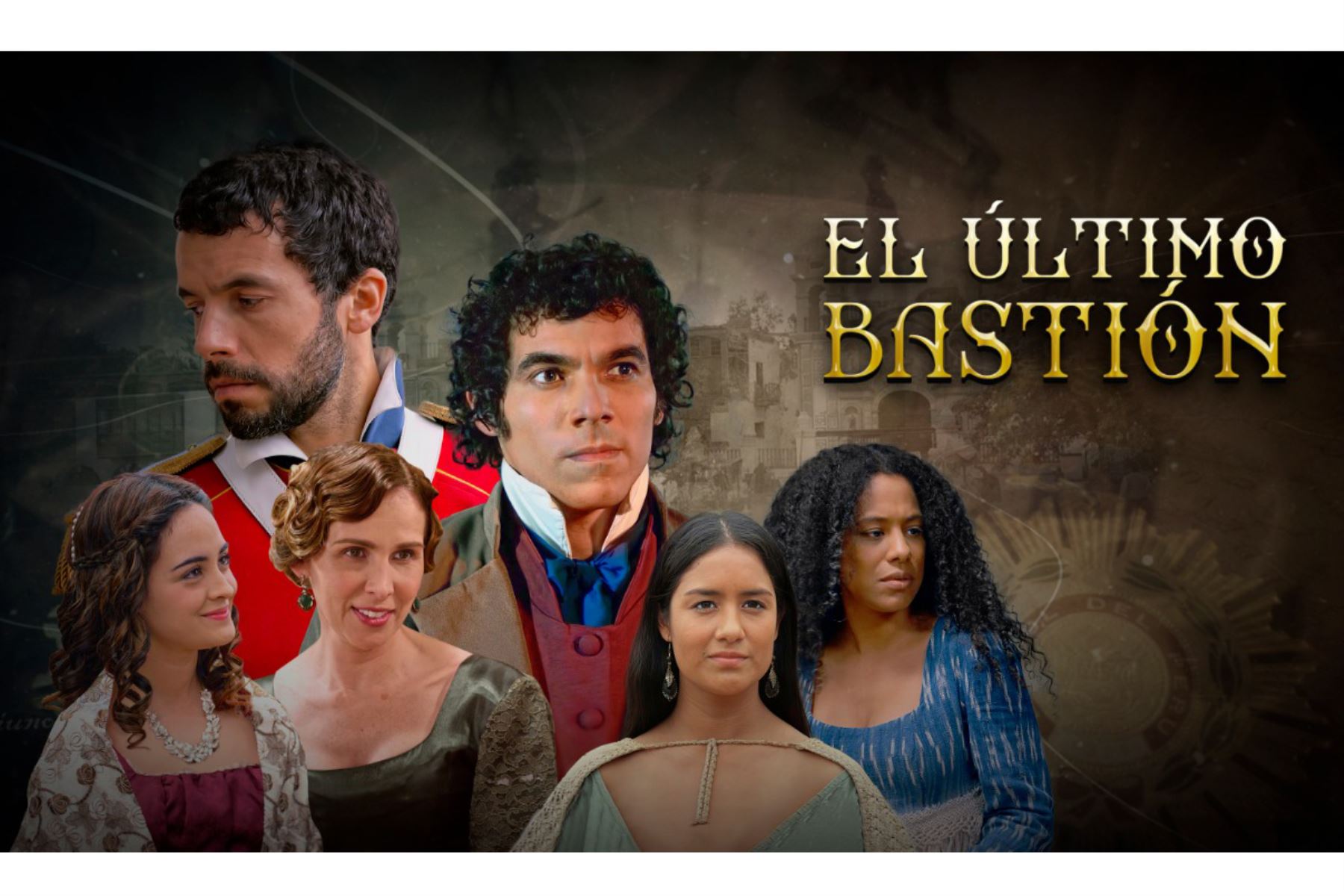La Tercera, the influential Chilean newspaper, qualifies the Peruvian series EL Último Bastión as a “masterpiece” and places it on a par with El Nombre de la Rosa, a top novel by Italian writer Umberto Eco. In the chronicle written by Pablo Lacoste , an academic from the University of Santiago, highlights the great performances, the colonial infrastructure, the gastronomy and the difference between this Peruvian production, broadcast to the world by Netflix, and the other Latin American series. Here the chronicle:
Through the Netflix platform, the Peruvian television masterpiece, El Último Bastión, has begun to be broadcast in Chile and the world.
It is an ambitious series, in which Peruvian filmmakers, actors, screenwriters and artists have played hard to put their country back at the center of Latin American culture, as in the golden era of the Viceroyalty of Peru.
The proposal shines for its constant desire to make visible the identity and cultural heritage of Peru, including architecture and gastronomy.
The fortress of El Callao and the colonial houses of Lima, with their balconies, offer an elegant and glamorous setting, together with the cane mats, the woven wickers, the indigenous handicrafts; To this is added the Peruvian gastronomy, especially the Causa Limeña, the anticuchos, the picarones and the artisan ice creams, then called “nieves”.
Peru’s passionate love for its cultural heritage is subtly displayed throughout this work (paradoxically, they forgot to mention Peruvian pisco).
Latin American Productions
Peru has played hard to compete with the great productions of other Latin American countries, broadcast worldwide by this platform: Venezuela (Bolívar), Colombia (Escobar, the patron of evil) and Argentina ( The Marginal).
Of all of them, the Peruvian proposal is distinguished by its cultural thickness, its intellectual depth and the detailed reconstruction of the material culture of the time, as well as a remarkable cast.
Unlike Escobar and the Peruvian series, it avoids falling into the morbid and easy apology of crime as a tool for attracting an audience. These series also use obscene violence too insistently to excite the viewer.
Instead, El Ultimo Bastión amazes and excites us from the depth of the script, and the exquisite way of representing the complex Latin American culture at the dawn of independence.
To find something similar, it would be necessary to go back to The Name of the Rose, that masterpiece by Umberto Eco, focused on a medieval abbey and its multiple cultural dimensions.
“At the height of The Name of the Rose”
In order to write it, Eco had to live a long intellectual life, and managed to capture in it the knowledge that we have today of the world of the year one thousand. In a similar journey, El Ultimo Bastión has managed to deliver, with remarkable fidelity, the secrets that we know today about the daily life of Latin America between 1780 and 1824.
In thirty years of filmography, this is the first work in Latin America that can be considered at the height of El Nombre de la Rosa.
The screenwriter is right when looking for a family of puppeteers and comedians, totally marginal in late colonial society, as an artistic resource to uncover the customs and customs of the time, the ideas, the ideological prejudices and the power mechanisms of the Old Colonial Regime.
They form a bar and hold dialogues with the family of indigenous and Afro-descendants who serve on the hacienda of the aristocratic family, Los Robles.
For the first time, the indigenous people are not shown as brutes barely dressed in rags: on the contrary, the women Micaela and Justina are presented with fine clothing of indigenous design and very well beaded with carved silver jewelry. An artistic resource to help us change the poor mental image that has been built for us through school and traditional historiography.
A South American culture
The series comes very close to telling us that it was the indigenous people who created, installed and spread in Peru, Chile and the arid west of Argentina, the culture of water, the culture of irrigation and the culture of agriculture.
The same goes for people of African descent. Instead of portraying them as gross and clumsy, as Hollywood commercial movies often do, in this series they are portrayed as intelligent, kind, lovable, skilled. It comes very close to saying that Afro-descendants were co-founders of the glamorous Southern Cone viticulture, as science has already shown.
The role of women in Spanish-Creole culture is another topic to be discovered. Science has already shown that women were legally considered “stupid”, that is, weak in body, soul and character. Therefore, she must always submit to the authority of a man: father, husband or brother.
In that sense, The Last Bastion effort is highly significant; because it will help us to better understand the cultural heritage that we received from the colonial period, and its frustrated overcoming. That racist and patriarchal system, which generates a culture of minimization and contempt for traditionally subordinate actors: indigenous, black, women, artists.
Latin American social reality
This series shows us in depth this aspect of Latin American social reality, providing a mirror in which we see ourselves reflected; In fact, it provides us with rich material for reflection, to understand where those impulses come from that our culture has naturalized around the treatment of contempt by these groups.
All this is done with subtlety, without low blows, with a very delicate respect for historical sources. In some cases, appeal is made to the artistic resource of the personification of a conceptual fact.
This is the case of the character of Constanza (María del Carmen Sirvas), the housekeeper of the main hacienda, who works as the jailer for women with a high social level and who censors all her initiatives; It tortures your conscience and takes away your peace and joy of living.
This work is very liberating, because it helps us understand ourselves; allows us to understand the cultural matrix where our society was formed. And in this way, it becomes easier to reflect and seek healing paths.
The performance of the actors is another relevant issue. As noted at the beginning, Peru put all the meat on the grill to shock the world with this series. And it shows in the cast. In some cases, outstanding performances were achieved. Omar García Serra is to José de San Martín what Sean Connery is to James Bond: the best performer, by far.
Great cast
Giovanni Arce (Republican lawyer Paco Robles) steals the series, with a smile that shows the soul of an angel. Rodrigo Palacios (realist officer Lorenzo Robles) is at the same height. Connie Chaparro (Rosa Campuzano) and Cindy Díaz (Manuelita Sáenz) shine with their magnetic personalities.
Two women deserve special mention who, from the popular field, provide wisdom and healing in their approaches: Mayra Najar (mulatto journalist María Mazombé) must disguise herself as a man to cultivate her craft.
This work, carried out by Channel 7 (state) of Peru, is called to generate great benefits for the socio-economic and cultural development of your country. It will serve to strengthen the identity and self-esteem of Peruvians, feeling represented by a work of such quality.
In addition, it will encourage receptive tourism, due to the public’s interest in knowing the architecture of Lima, the imposing fortress of El Callao and the colonial haciendas, along with their balconies and, above all, Peruvian gastronomy. This will generate millions of dollars for SMEs in the tourism sector throughout the country, as soon as the pandemic is overcome.
It would be interesting if other Latin American countries follow the Peruvian example; and instead of focusing on drug traffickers and criminals, begin to look better at heritage, culture and identity as themes to display artistically in movies and series.
More in Andina:
– .


